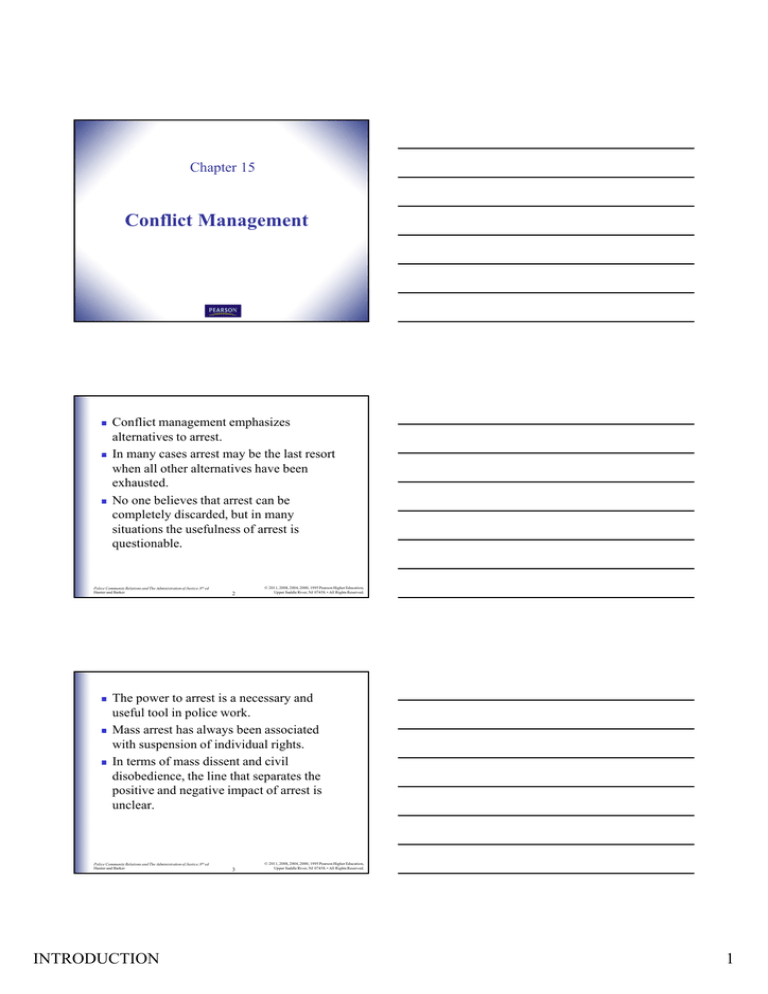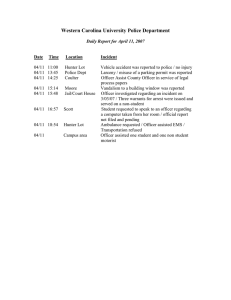
Chapter 15
Conflict Management
15-1
Conflict management emphasizes
alternatives to arrest.
In many cases arrest may be the last resort
when all other alternatives have been
exhausted.
No one believes that arrest can be
completely discarded, but in many
situations the usefulness of arrest is
questionable.
Police Community Relations and The Administration of Justice, 8th ed
Hunter and Barker
2
© 2011, 2008, 2004, 2000, 1995 Pearson Higher Education,
Upper Saddle River, NJ 07458. • All Rights Reserved.
The power to arrest is a necessary and
useful tool in police work.
Mass arrest has always been associated
with suspension of individual rights.
In terms of mass dissent and civil
disobedience, the line that separates the
positive and negative impact of arrest is
unclear.
Police Community Relations and The Administration of Justice, 8th ed
Hunter and Barker
INTRODUCTION
3
© 2011, 2008, 2004, 2000, 1995 Pearson Higher Education,
Upper Saddle River, NJ 07458. • All Rights Reserved.
1
Many arrests may aggravate, rather than
resolve, impending problems.
Conflict management focuses on working
with the community to identify areas of
conflict, defusing problems when they
arise, minimizing or preventing property
damage and violence through
communication, education, and/or
advocacy of community interests.
Police Community Relations and The Administration of Justice, 8th ed
Hunter and Barker
4
© 2011, 2008, 2004, 2000, 1995 Pearson Higher Education,
Upper Saddle River, NJ 07458. • All Rights Reserved.
Maintaining an Orderly Community
How do we maintain an orderly
community?
Police agencies in the United States have
been especially attuned to the difficult and
critical problem of doing so.
There is no prescribed formula to tell us
how to accomplish this task.
Police Community Relations and The Administration of Justice, 8th ed
Hunter and Barker
5
© 2011, 2008, 2004, 2000, 1995 Pearson Higher Education,
Upper Saddle River, NJ 07458. • All Rights Reserved.
A Partnership
Police officers are involved in a balancing act
between rigid enforcement and community
tolerances.
Before any alternatives, contingencies, or
strategies are developed, the department must
first acquire an in-depth knowledge of the
community and its problems.
Police Community Relations and The Administration of Justice, 8th ed
Hunter and Barker
INTRODUCTION
6
© 2011, 2008, 2004, 2000, 1995 Pearson Higher Education,
Upper Saddle River, NJ 07458. • All Rights Reserved.
2
This can only be accomplished by police
operating as a part of, and not apart from the
community.
The community must be convinced that its
police department is operating objectively
and is serving the community’s legitimate
interests to the best of its ability.
A partnership must exist between the police
and the community.
Police Community Relations and The Administration of Justice, 8th ed
Hunter and Barker
7
© 2011, 2008, 2004, 2000, 1995 Pearson Higher Education,
Upper Saddle River, NJ 07458. • All Rights Reserved.
Crisis Negotiations
Traditionally, police crisis negotiations have
meant hostage negotiations.
Crisis negotiations are best viewed as an
umbrella of activities in which hostage
negotiations are but one component.
This training should provide officers with the
skills and insights necessary for defusing
potentially volatile situations.
Police Community Relations and The Administration of Justice, 8th ed
Hunter and Barker
8
© 2011, 2008, 2004, 2000, 1995 Pearson Higher Education,
Upper Saddle River, NJ 07458. • All Rights Reserved.
Historically, police responses to conflict
management have been to use all due force
necessary to end the threat as quickly as
possible.
Hasty actions have too frequently led to death
and injuries to police officers, participants,
and innocent citizens.
They have also been catalysts for future
conflict.
Police Community Relations and The Administration of Justice, 8th ed
Hunter and Barker
INTRODUCTION
9
© 2011, 2008, 2004, 2000, 1995 Pearson Higher Education,
Upper Saddle River, NJ 07458. • All Rights Reserved.
3
Hostage Negotiations
Hostage situations are those where the
subjects hold another person or persons and
make demands on a third party.
These demands are usually for money, a
means to escape, a chance to air grievances.
Police Community Relations and The Administration of Justice, 8th ed
Hunter and Barker
10
© 2011, 2008, 2004, 2000, 1995 Pearson Higher Education,
Upper Saddle River, NJ 07458. • All Rights Reserved.
The hostage takers realize that the value of
their hostages remains in them staying alive.
Hostage takers understand harming the
hostages increases the risk that the police will
use force to resolve the crisis.
Law enforcement officials have learned to
handle these situations by stalling for time,
lowering the subject’s expectations, and
reversing their sense of empowerment and
control.
Police Community Relations and The Administration of Justice, 8th ed
Hunter and Barker
11
© 2011, 2008, 2004, 2000, 1995 Pearson Higher Education,
Upper Saddle River, NJ 07458. • All Rights Reserved.
The majority of all hostage incidents are
resolved without force because the hostage
takers prefer life to their demands.
Crisis negotiations not involving hostages are
more difficult to negotiate and have a higher
probability of violence.
These involve persons holding former
employees or coworkers; neighbors; spouses;
lovers or ex-lovers.
Police Community Relations and The Administration of Justice, 8th ed
Hunter and Barker
INTRODUCTION
12
© 2011, 2008, 2004, 2000, 1995 Pearson Higher Education,
Upper Saddle River, NJ 07458. • All Rights Reserved.
4
Domestic Disturbances
Domestic assault is the most frequent form of
violence that the police encounter.
The public and the police have long
recognized the need for skilled crisis
intervention in these police calls.
Police Community Relations and The Administration of Justice, 8th ed
Hunter and Barker
13
© 2011, 2008, 2004, 2000, 1995 Pearson Higher Education,
Upper Saddle River, NJ 07458. • All Rights Reserved.
Arrests deters domestic violence in some
cities and not in others based on a
combination of factors, such as race,
socioeconomic status, and the history of
violence among the participants.
Recent research has shown that there is no
one answer to conflict management in
domestic settings and that the police must
combine training with policy and use the law
along with other service agencies to reduce
the violence and manage the conflict.
Police Community Relations and The Administration of Justice, 8th ed
Hunter and Barker
14
© 2011, 2008, 2004, 2000, 1995 Pearson Higher Education,
Upper Saddle River, NJ 07458. • All Rights Reserved.
Individuals in Crisis
These are persons who demonstrate
inadequate coping skills when faced with
stressful life events and endanger themselves
or others
“Suicide by cop”
Crisis intervention teams
Police Community Relations and The Administration of Justice, 8th ed
Hunter and Barker
INTRODUCTION
15
© 2011, 2008, 2004, 2000, 1995 Pearson Higher Education,
Upper Saddle River, NJ 07458. • All Rights Reserved.
5
The subjects are unable to control their
emotions and are motivated by anger, rage,
frustration, hurt, confusion, or depression.
They have barricaded themselves or hold
their victims against their will and they make
no demands on the police other than to be left
alone to express their anger against the
person or persons they hold.
Time remains the best ally of the police.
Police Community Relations and The Administration of Justice, 8th ed
Hunter and Barker
INTRODUCTION
16
© 2011, 2008, 2004, 2000, 1995 Pearson Higher Education,
Upper Saddle River, NJ 07458. • All Rights Reserved.
6


